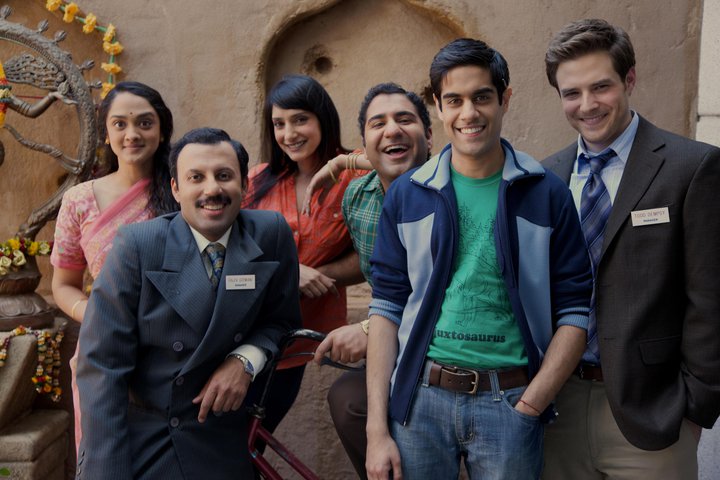
I must thank the sitcom "Outsourced" for inspiring me to write more about the Indian culture and expand on the theme of always wanting a direct answer to problems.
PLOT
The movie would begin in the morning of the Das family's trip with Mr. Kapasi to the Sun Temple at Konarak. In the beginning, Mrs. Das will be prepping herself for the day, unconcerned with getting the children ready. She stares blankly into the mirror, seemingly zoning out. As she turns, the camera panels over her view of three kids running around and Mr. Das sitting on the bed tying his shoe. She sighs; this whole scene envelops the hopelessness Mrs. Das feels and the disconnection towards her family. The car trip will remain the same, with Mr. Kapasi taking quick glances at Mrs. Das in the review mirror, only this time she won't say "Sounds romantic" when describing his job as translator for doctors. She will say distantly, "What a brave, strong job you have Mr. Kapasi." In this way, Mr. Kapasi takes her dreamy declaration to mean more than she means (he will of course be flattered by her brave comment, as most men are). She will take a picture with the tour guide and get his address same as in the short story. When the family stops so Mr. Das can take the children past the monkeys to take pictures, Mrs. Das immediately bursts into tears, expanding on her trapped feeling. She shares her story and sits and stares at Mr. Kapasi. He awkwardly stares back. Flicking her hand at him to talk, Mr. Kapasi realizes what is happening and he explains he cannot help this "malady" because it is not a malady to feel guilt. She then takes out his address, rips it up, throws it at his face, and trips out of the car.
POINT OF VIEW
In the film adaptation of "Interpreter of Maladies," the point of view most fitted for capturing all thoughts and motivations for actions would be third person omniscient. In this way, Kapasi's longing for Mrs. Das, or any woman outside his marriage, remains a focal point. A view that focuses in on all characters allows for direct acknowledgement of the children's treating parents as siblings. Mr. Das will easily be scene as more air-headed and disconnected to the feelings of Mrs. Das, contributing to her obvious loss of interest in her family. The story will focus on the Das family and Mr. Kapasi equally, however with more attention on Mrs. Das and Mr. Kapasi to show the longing Mr. Kapasi has for a woman and the longing Mrs. Das has for clearing of guilty conscience.


CHARACTERIZATION
The left image reflects my view of Mr. and Mrs. Das before they had children, before she committed adultery and before they lose love. The right image depicts the disconnected nature I foresee the Das's encountering as they grow old together. As far as characterization goes, Mrs. Das will remain unpleasant to her family and pleasant in the presence of Mr. Kapasi because she wants his attention in order to ask for her remedy; Mrs. Das is the using type. Mr. Das appears always off in his own little world, like one of the children. He portrays more of a big brother for the children, like in the short story, and less of a father. Mr. Kapasi shyly watches Mrs. Das for his chance to make a move; evidently, his shyness leads to shameful feelings when Mrs. Das explains he's the age of her father. Mr. Kapasi's innocent demeanor invokes sympathy for the love he does not have and the chance he is refused.SETTING

Naturally, altering the setting too much might distract from the longing feeling conveyed. Set in India, the Das family represents a feeling of longing for new places as the venture from the US to India. India, in all its beauty, poverty, customs, and landscape, will provide much for viewers to focus on; this ill contrast greatly with Mrs.. Das's obvious lack of interest with anything even when so much culture surrounds her. The Sun Temple presents the perfect place for Mr. Kapasi to teach Mrs. Das since he focuses on love and the temple itself is embellished with figures of love in action. Again, Mrs. Das is present at the temple, but her mind seems elsewhere, leading up to the point where she shares her story with Mr. Kapasi for more answers.
THEME
"Interpreter of Maladies" focuses on the fantasy Mr. Kapasi has of Mrs. Das, only in the movie it's based on her "brave and strong" remark. Both accounts capture the longing of the heart, whether that be for love or healing. In the short story, the slip of paper containing the tour guides address blows out of Mrs. Das's bag symbolizing the evaporation of the fantasy. Unlike the short story, the movie "The Guilty Malady" encapsulates the guilt of Mrs. Das and her adulterous acts; she holds onto the potential of Mr. Kapasi providing some remedy for this guilt. Overall, the movie will suggest the only remedy for guilty conscience is providing the truth. Because Mrs. Das cannot or will not accept this notion of Mr. Kapasi, she angrily tears up his address in front of his face. Instead of the paper blowing away, the tearing of it shows the immature nature of Mrs. Das and her inability to face the anger with herself; she executes this anger through hurting Mr. Kapasi.


